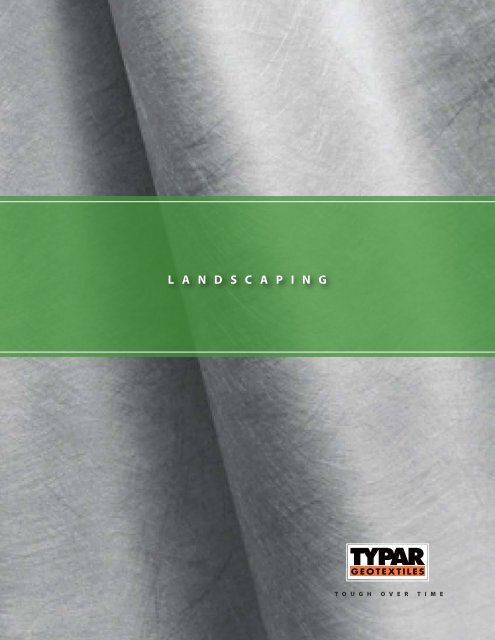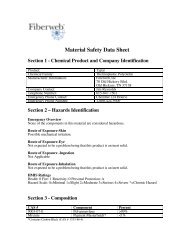Landscaping Brochure (PDF) - Fiberweb - TYPAR Geotextiles
Landscaping Brochure (PDF) - Fiberweb - TYPAR Geotextiles
Landscaping Brochure (PDF) - Fiberweb - TYPAR Geotextiles
Create successful ePaper yourself
Turn your PDF publications into a flip-book with our unique Google optimized e-Paper software.
L A N D S C A P I N G<br />
GEOTEXTILES<br />
T O U G H O V E R T I M E
LANDSCAPING<br />
1.0 Features oF LaNDsCaPING PG 2<br />
2.0 How tyPar GeotextILes PG 3<br />
work<br />
3.0 DesIGN CoNsIDeratIoNs aND PG 3<br />
seLeCtIoN oF GeotextILes<br />
GEOTEXTILES<br />
T O U G H O V E R T I M E<br />
4.0 INstaLLatIoN GuIDe PG 4<br />
5.0 overLaP aND joINING PG 8<br />
6.0 settING sPeCIFICatIoNs PG 8
<strong>TYPAR</strong> GEOTEXTILES T O U G H O V E R T I M E<br />
1.0 FEATURES OF LANDSCAPING<br />
In the broadest sense, a weed is a plant that grows<br />
where it is not wanted. Most weeds have no useful<br />
qualities. Furthermore, they can be very invasive,<br />
replacing other plants in their path, spreading quickly<br />
and competing for water and nutrients with desirable<br />
flowers and plants. Weeds are persistent and opportunistic<br />
and can thrive in the sparsest and rockiest of<br />
soils. Consequently, millions of dollars are spent every<br />
year chemically combating weeds.<br />
Weed seeds germinate by the thousands when the<br />
right habitat is created. Covering the ground with<br />
Typar alters the environment, making it more difficult<br />
for them to become established and easier for the<br />
gardener to control them.<br />
Figure 1: Weed growth restricted by Typar.<br />
Typar minimizes weed growth while allowing water,<br />
air and nutrients to pass freely through to plant<br />
roots. Typar restricts weed growth while ensuring<br />
desired plantings remain healthy. Little maintenance<br />
is required to provide protection from airborne weed<br />
seeds and overgrowth from nearby vegetation.<br />
In addition to weed control, Typar fulfills a number of<br />
other landscaping functions:<br />
• Soil retention behind log retaining walls<br />
• Simple stone drains<br />
• Weed control under decks<br />
• Separation layer under patios and paths<br />
• Soil retention in planter pots and hanging baskets
Plantar boxes 3<br />
Light duty weed control 3 3<br />
2.0 HOW <strong>TYPAR</strong> GEOTEXTILES WORK<br />
Typar offers a combination of properties that make<br />
it ideally suited for weed control, drainage and<br />
stabilization:<br />
• Highly permeable, allowing free flow of water,<br />
air and nutrients<br />
• Tight fiber structure prevents weeds from<br />
penetrating down through to the soil<br />
• Prevents piping or erosion of the subgrade soils<br />
• Tough, strong and durable<br />
• Easy to install<br />
• Resists fungal, biological and chemical attack<br />
Typar provides an effective drainage structure since it<br />
has both high permeability and the ability to restrain<br />
soil movement. This leaves behind the larger soil<br />
particles to form a more permeable graded soil filter<br />
adjacent to the Typar. This effectively stops the piping<br />
of the subgrade soils. Typar’s heatbonded, nonwoven<br />
structure makes it resistant to damage and stress<br />
during and after construction.<br />
3301 3341 3401 3501<br />
Heavy duty weed control 3 3 3<br />
Drainage 3 3 3 3<br />
Retaining walls 3 3 3<br />
Patios and paths 3 3 3<br />
Driveway stabilization 3 3 3<br />
Road stabilization 3 3<br />
Figure 2: Selection of Typar style in landscaping applications.<br />
In addition to its separation<br />
benefits, Typar<br />
geotextiles inhibit the<br />
growth of vegetation<br />
roots through its surface,<br />
while allowing water,<br />
air and fertilizer to pass<br />
through to plant roots in<br />
landscape applications.<br />
Typar restricts weed<br />
growth and ensures<br />
plantings remain<br />
healthy, while only light<br />
maintenance is required<br />
to provide protection<br />
from airborne seeds and<br />
overgrowth from nearby<br />
vegetation.<br />
Plastic films–often used to control weeds–are not<br />
permeable and do not allow water and fertilizer to<br />
pass through them, which starves the plant roots of<br />
nutrients, air and water. However, Typar’s high permeability<br />
permits water and fertilizer to pass through<br />
and reach the plant roots.<br />
When used behind retaining walls or for drains,<br />
Typar provides high permeability, allowing water<br />
to pass through openings and leaving soil particles<br />
behind, which effectively stops piping and prevents<br />
fine particle loss.<br />
3.0 DESIGN CONSIDERATIONS AND<br />
SELECTION OF GEOTEXTILES<br />
Typar geotextiles are available in a wide variety<br />
of styles and widths. Selection of the appropriate<br />
style is dependent on the application and<br />
installation (Figure 2).<br />
L A N D S C A P I N G I PAGE 3
<strong>TYPAR</strong> GEOTEXTILES T O U G H O V E R T I M E<br />
4.0 INSTALLATION GUIDE<br />
GARDEN MULCH<br />
(Figure 3)<br />
1. Clear and till the area, creating<br />
a smooth surface.<br />
2. Spread Typar over the entire<br />
section.<br />
3. Cover the Typar with organic<br />
mulch to hold moisture and<br />
give the garden a pleasant<br />
appearance.<br />
4. Cut X-shaped slits in the<br />
Typar for seeds and plants to<br />
grow through.<br />
5. Water and fertilize plants as<br />
recommended.<br />
Figure 3: Sequential procedure for using Typar with garden mulch.
PLANTER AND POT DRAINAGE<br />
(Figure 4)<br />
1. Line the container with Typar<br />
to allow water drainage without<br />
soil loss.<br />
2. Add soil and plants.<br />
BENEATH WOOD DECKS<br />
(Figure 5)<br />
1. Erect vertical posts for the deck.<br />
2. Unroll Typar on the ground and<br />
trim around vertical posts.<br />
3. Cover the Typar with at least<br />
4 inches of sand, gravel or mulch.<br />
TIMBER RETAINING WALLS<br />
(Figure 6)<br />
1. Excavate trench and build wall.<br />
2. Install Typar behind the wall.<br />
3. Backfill with soil or mulch.<br />
Note: An aggregate drainage<br />
system or drainage geocomposite<br />
may be required behind walls<br />
greater than 2 feet high.<br />
Figure 4: Soil retention for planters and pots.<br />
Figure 5: Weed control under decks.<br />
Figure 6: Soil retention for timber retaining walls.<br />
L A N D S C A P I N G I PAGE 5
<strong>TYPAR</strong> GEOTEXTILES T O U G H O V E R T I M E<br />
PATIOS AND PATHS<br />
(Figure 7)<br />
1. Clear all weeds and grass.<br />
2. Cut channel for patio or path and<br />
place Typar.<br />
3. Cover with at least 4 inches of sand or<br />
lean cement and place Typar.<br />
4. Lay bricks, blocks or slabs.<br />
5. Sweep any excess sand into the<br />
openings to prevent shifting.<br />
BLANKET DRAINS<br />
(Figure 8)<br />
1. Dig trench in the area to be drained<br />
to a lower area downhill, ensuring the<br />
slope is uniform.<br />
2. Line Typar along the length of the<br />
trench.<br />
3. Place drainage aggregate into the<br />
trench on top of the Typar.<br />
4. Lay perforated pipe, if required, and<br />
cover with aggregate.<br />
5. Wrap Typar over the sides and top<br />
of the aggregate.<br />
6. Backfill with soil and compact.<br />
Figure 7: Support for brick walkways.<br />
Figure 8: Blind drain.
Figure 9: Installation guide for underdrain construction.<br />
INTERCEPTOR TRENCH DRAINS<br />
(Figure 9)<br />
1. Excavate the trench.<br />
2. Install Typar, maintaining close contact with soil.<br />
3. Anchor top of Typar with stone to prevent falling<br />
back into trench.<br />
4. Place first layer of drainage stone.<br />
5. Install perforated drainage pipe.<br />
6. Cover pipe with drainage stone.<br />
7. Wrap Typar over the top of the stone.<br />
8. Place and compact soil or backfill.<br />
L A N D S C A P I N G I PAGE 7
<strong>TYPAR</strong> GEOTEXTILES T O U G H O V E R T I M E<br />
5.0 OVERLAP AND JOINING<br />
Overlaps provide continuity between adjacent<br />
geotextile rolls. Sufficient overlap is required to<br />
prevent fabric separation during backfilling. A<br />
minimum overlap of 12 inches is recommended.<br />
Pins or piles of stone may be used to maintain<br />
geotextile overlaps during installation. Geotextile<br />
overlaps at the end of rolls should be in the<br />
direction of the aggregate placement with the<br />
previous roll on top.<br />
6.0 SETTING SPECIFICATIONS<br />
Specifications should generally follow the<br />
design considerations in section 3.0. Primary<br />
considerations include the minimum geotextile<br />
requirements for the design retention, filtration<br />
and survivability.<br />
When specifying Typar geotextiles for landscaping,<br />
specify the appropriate Typar grade with the<br />
confidence that all Typar geotextiles are manufactured<br />
to the high quality standards required by the<br />
landscaping industry.
©2006 <strong>Fiberweb</strong><br />
GEO-06009 08/06<br />
FIBERWEB<br />
70 Old Hickory Blvd.<br />
Old Hickory, TN 37138 USA<br />
800-284-2780<br />
www.Typar<strong>Geotextiles</strong>.com<br />
www.<strong>Fiberweb</strong>.com<br />
Typar is a registered trademark of Reemay, Inc., dba <strong>Fiberweb</strong>, for use in North and South America, Israel, and<br />
South Africa for its polypropylene products.<br />
The information contained herein is, to the best of our knowledge, accurate and reliable and is provided for the user’s<br />
assessment and verification. However, since the circumstances and conditions under which such information and the<br />
products discussed can be used may vary and are beyond our control, we make no warranty, expressed or implied, of<br />
merchantability, fitness or otherwise, or of the results to be obtained, or against patent infringement and we disclaim all<br />
liability from any resulting damage or loss.<br />
Made in the U.S.A.




